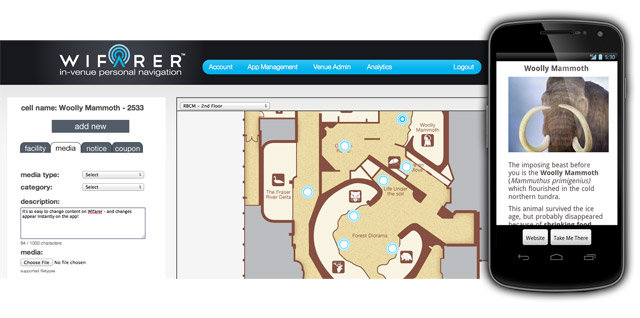Indoor positioning systems are on the rise and are meeting a service void for consumers. I don’t know about you, but I constantly use outdoor mapping apps for all variety of location needs. However when I step into a mall or museum or campus building, I can sometimes be left hanging, so to speak, with regard to my location.
That might be on its way to becoming a thing of the past.
Wifarer, just one of the new crop of indoor positioning companies out there, announces today that they are officially launching their new indoor mapping technology at the Royal BC Museum in Victoria, British Columbia, Canada.
Using a CMS based mapping system and free smartphone app, the company hopes to enhance visitor experiences and offer customized tours with real-time indoor navigation and automatic delivery of location-based content.
The company, which has piloted its technology at several locations in the past year (including the Royal BC Museum itself), is considering today’s announcement as an official “in production” launch.
Wifarer’s service is notable for a few reasons:
- It offers a Content Management System (CMS), for upload and control of location maps and map-specific content in those apps.
- It does not require venues to purchase, install or maintain custom hardware, like Cisco MSE routers or audio nodes, for example, and can work with a location’s existing WiFi infrastructure. In my mind, this makes the business model a bit more sustainable for merchants but also for Wifarer; Wifarer won’t have to sponsor hardware installs in order to get merchants to use the service, (something Shopkick has had to do in the past).
- Using a proprietary technology (based on robotics theory) it can use a venue’s existing Wi-Fi network to pinpoint the indoor location of a user’s smartphone with an average accuracy of four and a half feet.
- It offers a single “portal” app so consumers only have to manage a single app on their smartphone instead of separate venue apps for each location they are visiting.
A museum is a great model for extending location based venue content and self positioning, and Wifarer already has plans expand to several airports and hospitals, but I am immediately thinking of the retail potential.
Wifarer has thought of this too obviously, because since the location owns the WiFi system, they can control the content that can be distributed through it, allowing a high degree of customized, location-sensitive content. That would be beneficial to brands, but a spokesperson from the company was very careful to point out to me in a quick call that consumer privacy is extremely important to their designs and ultimately to consumer adoption.
Yes, the system allows smartphones to be located in reference to venue maps, but the phones are not tracked nor is any personal data stored. Consumer foot traffic data could be calculated but all the consumer data is completely anonymous. Their focus is truly on a consumer app.
As noble as that sounds, it makes me wonder if that could be a miss for some retailers who want consumer data. Or if there is an opt in scenario in the future where consumers could have the opportunity to give up some info in return for better, more targeted retailer information or offers.
I also have to wonder if the portal model of a single consumer app is what individual retailers will actually want. Don’t get me wrong — it makes total sense for super-locations that house other smaller individual venues, like a mall or an airport or hospital. It also makes sense for institutions that may be lacking their own app or who may not have a detailed mobile strategy in place. Still, my experience in retail strategy leads me to believe that many retailers out there crave a single unified experience and total control of their content, location or otherwise. There may need to be an integration solution in place for this to get traction with individual retailers — if that is a goal.
However, it also is important to note that distributing these maps through a portal could offer extreme cost savings to a brand since they will not have to incur development costs to integrate into their own mobile web or app properties. So it would just be a trade off.
How does Wifarer make money? There are some setup and service fees, but there is also a revenue sharing model with content in the maps.
Android and iOS versions of the app are here.
